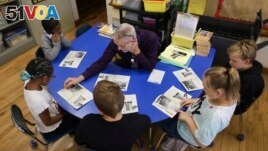23 May 2023
The COVID-19 pandemic disrupted learning across the world. As students are back in class, some are much more behind than others.
In the United States, teachers are working hard to help students make up for missed learning. Many schools are judging individual students' knowledge and making lesson plans especially for them.
Richard Evans is a third-grade teacher in Niagara Falls, New York. Most of his students were sent home as kindergartners in March 2020. Many spent all of first grade learning from home.

Richard Evans, a teacher at Hyde Park Elementary School, helps Ke'Arrah Jessie sound out a word during a reading circle in class on Thursday, Oct. 20, 2022, in Niagara Falls, N.Y. (AP Photo/Joshua Bessex)
Problems did not end when schools reopened for second grade. There were face covering and social distancing requirements. And many were not used to spending full weeks of study in school.
"I had kids ask me, `Why do I have to be in school for five days?'" Evans said.
The pandemic affected each of Evans' 24 students differently. So, he changed his instruction depending on individual students' needs.
The students in his class who had fallen behind learn to read by moving their fingers slowly beneath words. They sound the words out one syllable at a time. They are practicing skills usually learned in first grade like sounding out "ch" and "sh" sounds.
As the students read, Evans notes their understanding and speaking ability. He also writes down words that students have difficulty with.
And after a year of doing this and following the results, he says it appears to be working.
Moving from "learning to read" to "reading to learn"
At the start of this school year, tests showed that 15 of Evans' students were reading below grade level. Of those, nine were considered severely behind.
In October, six students sat around Evans at a table. Each was reading a first-grade book about baseball star Willie Mays.
"What sound does ‘-er' make?'" Evans asked one 9-year-old student. She put "hit" and "ter" together to make "hitter." Next to her, a boy said the word "high" as "hig."
There was no time to waste. Third-grade students are under urgent pressure to progress from "learning to read" to "reading to learn." Studies show those who do not learn to read with ease by the end of third grade are more likely to drop out or finish high school late.
One who fell behind is Ke'Arrah.
She spent more than a year learning remotely early in the pandemic. Her mother, Ashley Martin, wanted her to be safe but saw how it was affecting her daughter's education. So, when Ke'Arrah went to a new school this year, she had her repeat third grade.
Midway through her second time in third grade, the decision appeared to be working.
Mother and daughter are now reading together at bedtime. And even small moments become reading lessons, too.
"She's on the phone, I'm like: ‘Read that to me. Tell me, what does that say?' We're out somewhere: ‘Read this to me. What does it say?'" Martin said.
Spending time with those who need it most
While many students are behind, Evans also sent more students than ever to the school's honors program because of their high test scores. Those students sometimes work independently or with each other to give Evans extra time with those who need more help.
Evans invested his own time in one of the neediest students. He kept a boy after school once a week for more reading.
In one exercise, Evans asked the boy to close his eyes, think about the first sound of each word and sound it out. After a few weeks, the boy went from knowing just 11 common words to 66 on the third-grade reading list.
Halfway through the school year, a new set of tests suggests Evans' plan is working. Fifteen of his students had met or went beyond their goals.
And Ke'Arrah went from the bottom level of the class to the upper middle.
I'm Dan Novak.
Dan Novak adapted this story for VOA Learning English based on reporting by The Associated Press.
______________________________________________________________________
Words in This Story
kindergarten — n. a school or class for very young children
kid — n. a young person
syllable — n. any one of the parts into which a word is naturally divided when it is pronounced